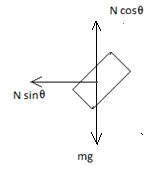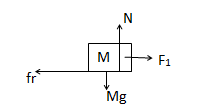11th And 12th > Physics
NEWTON S LAWS WITH FRICTION AND BEYOND MCQs
A civil engineer wishes to redesign the curved roadway in such a way that a car will not have to rely on friction to round the curve without skidding. In other words, a car moving at the designated speed can negotiate the curve even when the road is covered with ice. Such a ramp is usually banked, which means that the roadway is tilted toward the inside of the curve. Suppose the designated speed for the ramp is to be 10.0 m/s and the radius of the curve is 20.0 m. At what angle should the curve be banked?
A scooter starting from rest moves with a constant acceleration for a time Δ t1, then with a constant velocity for the next Δ t2, and finally with a constant deceleration. A person of mass 50 kg on the scooter, behind the driver manages to stay at rest with respect to the scooter without touching any other part. The force exerted by the seat on the man is
Take g=10m/ s2
:
D
So when scooter is accelerating the man is also accelerating along with it so friction from the scooter's seat on man is making him move forward.
Also there is a Normal force
N = mg = 500 N
So Net force while accelerating will be √(500)2+(fr)2 > 500
Same is true about decelerating
So while accelerating or decelerating the force on man by scooter is more than 500N. When the scooter is going with constant velocity, the man is also going with constant velocity. So 0 acceleration in horizontal direction so no net force in horizontal direction so no friction.
Only Normal N = mg = 500
:
B
Now if the angle made by Fc and the vertical decreases then horizontal componenet decreases
As you can see the horizontal component decreases, Which in this case turns out to be frictional force.
Yes the magnitude of frictional force depends upon the angle made by Contact force and the Vertical/Horizontal
:
C
If F1 = 0
So contact force will only have Normal which is equal to Mg
So F will be Mg
Now as F1 increases fr keeps increasing till it reaches limiting value i.e., μN = μ mg
So, in that case, contact force F will be
√N2+fr2 = √(Mg)2+(μMg)2
F = Mg √1+μ2
This means contact force F will lie between Mg ≤ F ≤ Mg √1+μ2
:
A
Let the contact force on the block by the surface be F which makes an angle θ with the vertical
The component of F perpendicular to the contact surface is the normal reaction N and the component of F parallel to the surface is the well-known frictional force f. As the surface is horizontal, N is vertically upward. For vertical equilibrium,
N = mg = (0.400 kg) 10ms2 = 4.0 N.
The frictional force is f = 3.0 N.
(a)
Or, θ = tan−1 ( 34) = 37∘.
(b)The magnitude of the contact force is
F = √N2+f2
= √(4.0N)2+(3.0N)2 = 5.0 N.
:
A
Block A moves in the leftward direction with respect to B. ∴ Friction will act in the rightward direction on A. As the bonds formed will oppose the relative motion.
:
C and D
Limiting friction = μs mg
So till F ≤ fr
F = fr
So straight line at angle 45∘
After that even if Force F increases the value of friction will be fixed at μK mg
So straight line also μK < μs
So there will be kink.
Spring fitted doors close by themselves when released. You want to keep the door open for a long time, say for an hour. If you put a half kg stone in front of the open door, it does not help. The stone slides with the door and the door gets closed. However, if you sandwich a 20 gm piece of wood in the small gap between the door and the floor, the door stays open. Explain why a much lighter piece of wood is able to keep the door open while the heavy stone fails. Assume coefficient of friction between stone and ground and wood and ground are the same.
:
C
In this case, the door will apply a downward force on the wooden piece which will increase the normal force that the ground applies on the wooden piece. ∴ Limiting value of friction will increase.

:
B
As the external force F is gradually increased from zero it is compensated by the friction and the string bears no tension. When limiting friction is achieved by increasing force F to a value till μs mg, the further increase in F is transferred to the string.
When[F<μsmg;The friction is static and T = 0F≥μsmg;T=F−μsmg]






















